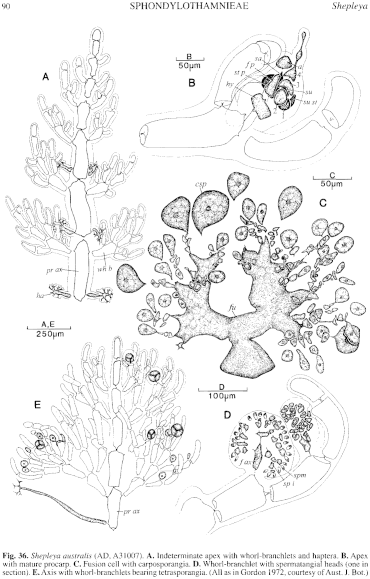|
|
|
|
|
|||||||||||
|
Electronic Flora of South Australia Species Fact Sheet
Phylum Rhodophyta – Order Ceramiales – Family Ceramiaceae – Tribe Sphondylothamnieae
Selected citations: Huisman & Walker 1990: 425. Silva et al. 1996: 424. Wollaston 1984: 297, fig. 30.
Synonyms
Callithamnion australe J. Agardh 1841: 42; 1851: 26; 1876: 21; 1885: 2. Kützing 1849: 649. Sonder 1881: 10.
Antithamnion australe (J. Agardh) De Toni 1903: 1407. Lucas 1909: 51. Wollaston 1968: 300.
Thallus (Fig. 36A) red-brown, prostrate with axes creeping along the host (usually Pterocladia lucida) branches, branching opposite or alternate; attachment by haptera; epiphytic. Structure. Subapical cells producing opposite, distichous pairs of whorl-branchlets (Fig. 36A), axial cells enlarging to 180–190 µm in diameter and 400–500 µm long near the base; whorl-branchlets 500–1000 µm long, oppositely and distichously branched in the plane of the host surface, with the basal cell usually producing 1–3 more laterals in the plane of branching; terminal cells with rounded ends, median cells 55–85 µm in diameter and L/D 2–4; haptera in opposite pairs from the lower ends of axial cells. Indeterminate branches develop by continued growth of whorl-branchlets. Cortication absent. Cells multinucleate; rhodoplasts discoid to elongate.
Reproduction: Gametophytes dioecious. Female axis (Fig. 36B) 4–12 cells long, arising at branch apices, with the last 3 cells shorter. Procarps as in S. wattsii with the subapical cell bearing a sterile pericentral cell, a fertile pericentral cell producing the second auxiliary cell, and the supporting cell with an apical sterile cell and lateral carpogonial branch. The fusion cell (Fig. 36C) is furcate, cutting off small gonimoblast cells with ovoid to pyriform terminal (and subterminal) carposporangia 40–90 µm in diameter; the apical cell and sterile pericentral cell divide after fertilization to form 2 inner involucral branchlets while the subhypogenous cell bears 3 outer involucral filaments which together with the inner branches curve up and around the carposporophyte. Spermatangial heads (Fig. 36D) are slightly ovoid and 70–110 µm in diameter, borne on curved cells of the whorl-branchlets.
Tetrasporangia (Fig. 36E) are sessile on upper cells of whorl-branchlets where free from the host edge, 50–90 µm in diameter, tetrahedrally divided.
Type from Port Phillip, Vic. (Brown); holotype in Herb. Agardh, LD, 17960.
Selected specimens: (all on Pterocladia lucida, except A31270): Garden I., W. Aust., under reef ledges (Chittleborough, 21.ix.1966; AD, A31007). Cannan Reefs, S. Aust., 20–25 m deep (Branden, 21.i.1991; AD, A61082). El liston, S. Aust., upper sublittoral pools (Gordon, 16.v.1968; AD, A32158). West Point, Eyre Pen., S. Aust., 15–25 m deep (Shepherd, 25.x.1969; AD, A34767). Wedge I., S. Aust., 11 m deep (Baldock, 28.xii.1963; AD, A27243). Daly Head, Yorke Pen., S. Aust., drift (Gordon, 26.iii.1967; AD, A31338 and on Zonaria crenata, AD, A31270). Stanley Beach, S coast Kangaroo I., S. Aust., drift (Womersley, 6.ii.1957; AD, A20916). Young Rocks, S of Kangaroo I., S. Aust., 16–30 m deep (Branden, 18.vi.1991; AD, A61464). Port Phillip, Vic. (MEL, 10267, probable isotype). Point Lonsdale, Vic., 12 m deep (Macpherson, 15.v.1963; AD, A28572).
Distribution: Rottnest I., W. Aust., (Huisman & Walker) to Port Phillip, Vic. South Africa (Wollaston 1984, p. 297).
References:
AGARDH, J.G. (1841). In historiam algarum symbolae. Linnaea 15, 1–50, 443–457.
AGARDH, J.G. (1851). Species Genera et Ordines Algarum. Vol. 2, Part 1, I-XII, 1–336 + index. (Gleerup: Lund.)
AGARDH, J.G. (1876). Species Genera et Ordines Algarum. Vol. 3, Part 1- Epicrisis systematic Floridearum, pp. i-vii, 1–724. (Weigel: Leipzig.)
AGARDH, J.G. (1885). Till algernes systematik. VII. Florideae. Acta Univ. lund. 21, 1–120, Plate 1.
DE TONI, G.B. (1903). Sylloge Algarum omnium hucusque Cognitarum. Vol. 4. Florideae. Sect. 3, pp. 775–1521 + 1523–1525. (Padua.)
GORDON, E.M. (1972). Comparative morphology and taxonomy of the Wrangelieae, Sphondylothamnieae and Spermothamnieae (Ceramiaceae, Rhodophyta). Aust. J. Bot. suppl. 4, 1–180.
HUISMAN, J.M. & WALKER, D.I. (1990). A catalogue of the marine plants of Rottnest Island, Western Australia, with notes on their distribution and biogeography. Kingia 1, 349–459.
KÜTZING, F.T. (1849). Species Algarum. (Leipzig.)
LUCAS, A.H.S. (1909). Revised list of the Fucoideae and Florideae of Australia. Proc. Linn. Soc. N.S.W. 34, 9–60.
SILVA, P.C., BASSON, P.W. & MOE, R.L. (1996). Catalogue of the Benthic Marine Algae of the Indian Ocean. (University of California Press: Berkeley, Los Angeles & London.)
SONDER, O.W. (1881). In Mueller, F., Fragmenta Phytographiae Australiae. Supplementum ad volumen undecinum: Algae Australianae hactenus cognitae, pp. 1–42, 105–107. (Melbourne.)
WOLLASTON, E.M. (1968).Morphology and taxonomy of southern Australian genera of Crouanieae Schmitz (Ceramiaceae, Rhodophyta). Aust. J. Bot. 16, 217–417.
WOLLASTON, E.M. (1984). Species of Ceramiaceae (Rhodophyta) recorded from the International Indian Ocean Expedition, 1962. Phycologia 23, 281–299.
The Marine Benthic Flora of Southern Australia Part IIIC complete list of references.
Publication:
Womersley, H.B.S. (24 December, 1998)
The Marine Benthic Flora of Southern Australia
Rhodophyta. Part IIIC. Ceramiales – Ceramiaceae, Dasyaceae
©State Herbarium of South Australia, Government of South Australia
Illustration in Womersley Part IIIA, 1998: FIG. 36.

Figure 36 enlarge
Fig. 36. Shepleya australis (AD, A31007). A. Indeterminate apex with whorl-branchlets and haptera. B. Apex with mature procarp. C. Fusion cell with carposporangia. D. Whorl-branchlet with spermatangial heads (one in section). E. Axis with whorl-branchlets bearing tetrasporangia. (All as in Gordon 1972, courtesy of Aust. J. Bot.)

|
Email Contact: State Herbarium of South Australia |

|